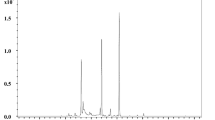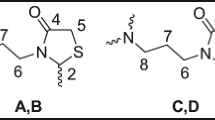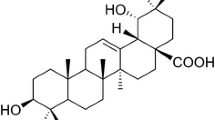Summary
The antinociceptive action of tizanidine [5-chloro-(2-imidazolin-2-yl-amino)-2,1,3-benzothiadiazole], a centrally acting muscle relaxant, was evaluated after subcutaneous or peroral administration in mice and rats. Tizanidine strongly inhibited the writhing response induced by acetic acid, phenyl-p-benzoquinone and acetylcholine in mice, and its potency was found to be greater than that of morphine. Tizanidine showed antinociceptive action like morphine not only in tail pressure and electrical stimulation tests in mice but also in tail-flick tests in mice and rats. The antinociceptive action of tizanidine was unaffected by pretreatment with naloxone. These findings suggest that tizanidine develops relatively strong antinociceptive action by a nonopioid mechanism.
Similar content being viewed by others
References
Bragstad A, Blikra G (1979) Evaluation of a new skeletal muscle relaxant in the treatment of low back pain (a comparison of DS 103-282 with chlorzoxazone). Curr Ther Res 26:39–43
Collier HOJ, Dinneen LC, Johnson CA, Schneider C (1968) The abdominal constriction response and its suppression by analgesic drugs in the mouse. Br J Pharmacol 32:295–310
Coward DM (1981) Selective muscle relaxant properties of tizanidine and an examination of its mode of action. Triangle 20:151–158
Courvoisier S, Ductor R, Julov L (1957) Nouveaux aspects expérimentaux de pactivité centrale des dérivés de la phénothiazine. In: Grattini S, Ghetti V (eds) Psychotropic drugs. Elsevier, Amsterdam, pp 373–391
D'Amour FE, Smith DL (1941) A method for determining loss of pain sensation. J Pharmacol Exp Ther 72:74–79
Davies J, Johnston SE (1984) Selective antinociceptive effects of tizanidine (DS 103-282), a centrally acting muscle relaxant, on dorsal horn neurones in the feline spinal cord. Br J Pharmacol 82:409–421
Flint BA, Ho IK (1980) Tolerance development to phencyclidine by chronic administration. Prog Neuro-Psychopharmacol 4:233–239
Fryda-Kaurimsky Z, Mueller-Fassbender H (1981) Tizanidine (DS 103-282) a new muscle-relaxant. J Int Med Res 9:501–505
Gerstenbrand F, Lorincz A, Ludin HP, Ringwald E (1979) Langzeit-behandlung mit dem Imidazolinderivat DS 103-282. Nervenarzt 50:806–808
Green AF, Young PA, Godfrey EI (1951) A comparison of heat and pressure analgesiometric methods in rats. Br J Pharmacol 6:572–595
Grewal RS (1952) A method for testing analgesics in mice. Br J Pharmacol 7:433–437
Janssen PAJ, Niemegeers CJE, Dony JGH (1963) The inhibitory effect of fentanyl and other morphine-like analgesics on the warm water induced tail withdrawal reflex in rats. Arzneimittel-Forsch 13:502–507
Koster R, Anderson M, Deber EI (1959) Acetic acid for analgesic screening. Fed Proc 18:412
Lepisto P (1979) A comparative trial of DS 103-282 and placebo in the treatment of acute skeletal muscle spasms due to disorder of the back. Curr Ther Res 26:454–459
Litchfield JT, Wilcoxon F (1949) A simplified method of evaluating dose-effect experiments. J Pharmacol Exp Ther 96:99–113
Ringwald E, Compean SJ, Gerstenbrand F, Lorincz A, Lorincz P, Ludin HP (1977) Klinische Erfahrungen mit einem neuartigen Myotolytikum (DS 103-282 Sandoz). Nervenarzt 48:355–358
Sayers AC, Burki HR, Eichenberger E (1980) The pharmacology of 5-chloro-4-(2-imidazoline-2-yl-amino)-2,1,3-benzathiadiazole (DS 103-282), a novel myotonolytic agent. Arzneimittel-Forsch 30:793–803
Siegmund E, Cadmus R, Lu G (1957) A method for evaluating both non-narcotic and narcotic analgesics. Proc Soc Exp Biol Med 95:729–731
Yamada S, Sugimoto A, Nabeshima T, Kameyama T (1984) Changes in tizanidine-induced antinociception and motor coordination following successive administration of tizanidine. Folia Pharmacol Japon 83:Suppl 8
Woolfe G, Macdonald AD (1944) The evaluation of the analgesic action of pethidine hydrochloride (Demerol). J Pharmacol Exp Ther 80:300–307
Author information
Authors and Affiliations
Rights and permissions
About this article
Cite this article
Kameyama, T., Nabeshima, T., Sugimoto, A. et al. Antinociceptive action of tizanidine in mice and rats. Naunyn-Schmiedeberg's Arch. Pharmacol. 330, 93–96 (1985). https://doi.org/10.1007/BF00499900
Received:
Accepted:
Issue Date:
DOI: https://doi.org/10.1007/BF00499900




